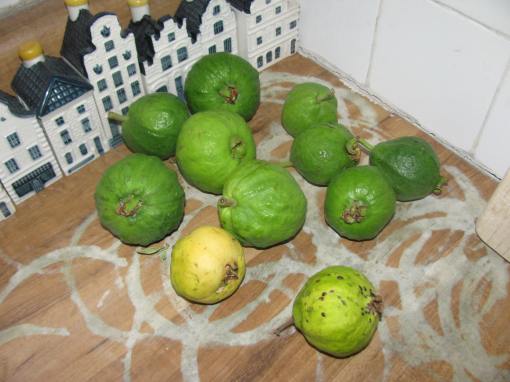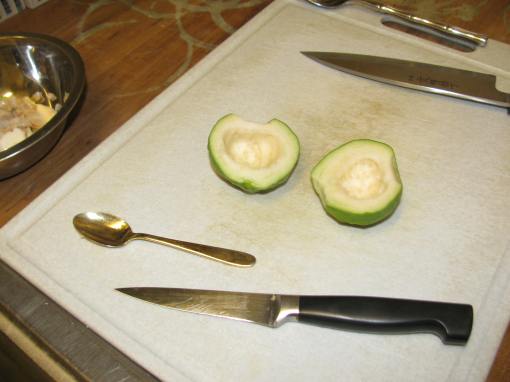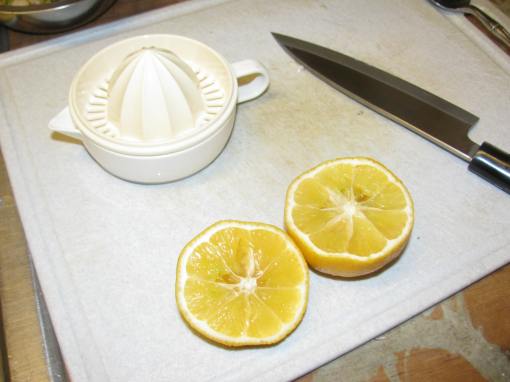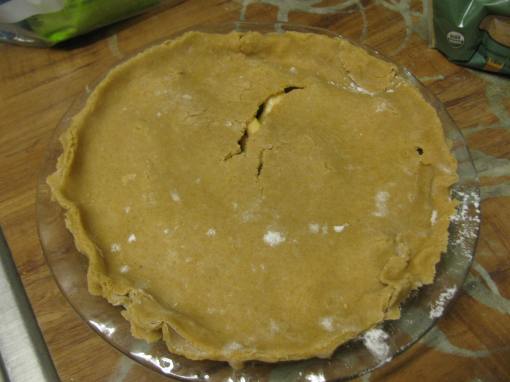Each year our guava tree produces far more guavas than we can eat, so this time I got a little more assertive in finding uses for them.
Listen while you read to an informal recording of a live performance of “Falling”, another unpublished Panache piece. (And sorry about all the wind noise in the mic. I hadn’t thought to put the screen on. Hopefully we’ll get a cleaner take one of these days.)
07 September 2012
Since we moved to Chinatown almost four years ago we have been faced with a somewhat perplexing situation on an annual basis: Guava Season. The duplex we rented half of came with a little guava tree in the tiny front yard that has produced a bonanza of guavas each fall.

The guava tree laden with ripening guavas
Why is this perplexing? Well, several reasons:
Reason #1 is that there has apparently been a tradition of many of the neighbors interpreting it as “open season” and letting themselves into our garden to help themselves to the bounty and trampling all over my other plants in the process, compacting the soil that I have spent endless back-breaking, sweaty hours digging and massaging into a light, fluffy condition each season. I finally got sufficiently fed up with that and rigged up a fence last spring.

A lesser reason is our general lack of experience with guavas. I can’t believe I’ve lived as long as I have without having ever eaten a guava before we moved to C-town and acquired this tree. I didn’t even know how to eat one, and one day a frequent visitor to our next door neighbors’ picked one off the tree that was in season at the time, handed it to me, and said to just take a bite. It didn’t look quite ripe to me and I found it a little too hard and astringent for my liking and it was also full of really hard seeds, but our landlord had said that guavas were a “super food”, so Chi and I decided to try them. As they ripen up, they turn from dark green to lime green to the yellow of a ripe lime and by that point start to smell increasingly pungent the riper they get. Nevertheless, there are only two of us and we can only eat so many, so what has traditionally been happening so far is that we eat a few, a bunch end up getting too ripe and end up in the compost bin, and we give the rest to the neighbors.
Another minor issue is that the overripe ones in inaccessible places drop down into the garden and I end up with dozens of little guava trees sprouting up all over the place, but that’s not a big deal. It becomes a big deal, however, when Chi and I do the Annual Guava Tree Whack-Back in which I prune the guava tree way down after it finishes producing fruit for the year to allow sunlight to get to the the “ground floor” of the Panache Garden. The tree has grown quite a bit since we’ve lived here, and between it and the banana plants I put in during our first spring here, they have developed such a dense canopy the past couple years that it almost completely overshadows the whole yard, making it quite challenging to grow anything else. This pruning operation drives the timing for my fall planting (fall is actually the most productive gardening season in SoCal) since it makes no sense to have heavy guava branches falling down on tiny seedlings and crushing them, and nothing would even sprout anyway due to the lack of light until I cut the tree back.
Well, this year we’ve been managing the guava harvest more carefully and eating more of them, and I decided to get adventuresome and find other ways to use them. I decided to try making a guava pie! While researching guavas, in addition to learning about their myriad health benefits, I finally learned that there is a way of paring them that makes them easier to eat: cut them in half and scoop out the seeds first. There is no need to peel them (at least the variety that our tree produces) since the skin is so delicate and thin and full of vitamins.
I settled on using a recipe for a “traditional” American-style apple pie as a reference, and put together a double crust using my favorite recipe from Tarte du Jour, one of my favorite foodie blogs curated by Lisa McDonnell (the crust recipe is at the bottom of the lovely Apple tart recipe here: http://www.tartedujour.com/journal/2012/2/28/tarte-aux-pommes-a-la-creme-a-classic-from-normandy.html
Next, I began preparing what I hoped would be enough guavas to fill the pie. After setting out two bowls (one big one to put the finished guava slices in and a little one to put the scraps that would go in the compost), I selected one very large one, three regular-sized ones and four small-ish ones at varying stages of ripeness from the lot occupying one side of our kitchen counter. After rinsing them, I cut them in half and then trimmed off whatever there was at the flower end that I didn’t want to end up in the pie, i.e., excess skin flaps, fuzzy stuff from the flower, etc. I observed that the riper they get, the less of that stuff there is to have to trim off. I didn’t bother taking the skin off since it’s very thin and that would have taken all night. The texture of the guavas felt rather pear-like as I handled them.

The latest batch of guavas we’d picked. Don’t ask me what happened to that countertop. It was like that when we moved in. We did however add the street scene from 18th century Delft though 😉

I then scooped out the seeds with a little spoon and discovered that the less-done ones were a lot more work to scoop the seeds out of. I kept my slices thin and decided to let them sit in lemon juice to digest a bit, hoping that would help soften them up. I had actually meant to use juice from a bunch of key limes I’d gotten from a friend at my day job to play up the tropical flavour, but unfortunately forgot and used a lemon from the neighbor’s tree out back that was conveniently out on the countertop instead. I wondered how this was going to turn out after all this work. Maybe I’ll just find out the reason why there aren’t any recipes for pies made w/fresh guavas??





the “finished” guavas

Into the compost bucket with the seeds and stuff!
Once all the guavas were cut and macerating in lemon juice, I took the crust out of the refrigerator to warm up a bit before rolling it out and added some sugar to the guavas. The recipe I was referring to called for a whopping two cups of sugar for three apples (I think the recommended type were Golden Delicious, which are sweet already!), but that sounded way too sweet for me, so I cut it down to one cup for the mix of eight not-quite-ripe (= astringent/sour) to a little over-ripe (= sweet-sour-ish) guavas and hoped that would balance out well. I would have used palm sugar if I’d had more of it on hand, again to enhance the tropical theme, but instead used the sugar I had a lot of: a combination of evaporated cane juice crystals and plain old light brown.
Time to roll out the dough. Since I do not have a pastry board (or a good rolling pin!), and just a funky, very wrinkly old pastry cloth that I spread on the slippery formica countertop to roll dough on, it started slipping and sliding around, so I ghetto’d up and duct-taped the cloth in place. DAMN IT! The dough totally went to shit and started breaking up all over the place! I scurried back to the office room to Google up an explanation for what to do when that happens, and the video that came up said to just ease it into the pie plate, treating it gently, and piece it together, so that is what I did.

ghetto-taped pastry cloth – so far so good!

I hate when that happens!

Piecing the dough together

All better! Ready to put the guavas in.
After that ordeal, I chucked a teaspoon or so of cinnamon into the guava bowl plus another half-teaspoon of ground allspice and a generous splash of Grand Marnier liqueur, which is my personal spice mix for apple pies. I didn’t add any extra flour since I didn’t think the guavas would produce as much juice as apples. I then gave it a good stir to make sure all the guava pieces got evenly covered in sweet, spicy, syrup-y goodness and hope I’d have better luck with the top crust. And no, I’m not going to spend another hour trying to arrange the guava pieces prettily in a perfect series of overlapping concentric circles. Remember, this pie went Ghetto when we busted out the duct tape, so I’ll just dump them in and smooth them out a bit.

Adding the spices to the mix

OK, good enough for rock ‘n roll!
The top crust was indeed easier to roll out (there’s a razor-fine line between just warmed enough to roll without disintegrating, and getting too squishy, which the top crust pretty much was by this point. It ended up with a good-sized steam hole built into it where it split in the middle as I was rolling it.

Much better!

Ok, into the oven!
MERDE! I’d forgot to dot the pie with butter before putting the top crust on since I was so anxious to get it on without another big production of having to patchwork it together again 😦 Now put it in oven and wait….
Well, that pie ended up sitting in the microwave oven for the entire next day (that’s where we keep things that we don’t want the Panache Cats, ants, flies and other unwelcome critters getting into when they’re still too hot to put in the fridge), and I didn’t end up getting to try it until the following morning at breakfast. It seemed a little mushy, and of course the first slice I cut out turned into a big mess. I picked up my fork and took a bite…
Drum roll…..SUCCESS!!! HOORAAAAAAAY!!! The pie was delicious! The too-ripe guavas tasted a tad pungent, but the not-ripe-enough ones and just-right ones were fine, and it wasn’t suffering at all from my forgetting to put the butter in. The taste was tropical and bright, a perfect blend of sweet-tart-spicy that allowed the flavour of the guavas to shine through! I just wish I could figure out how to make the crust more flakey and less gritty. I wonder if it’s because I use whole wheat pastry flour cut with whole wheat regular flour (the rough gritty kind that won’t go through the sifter, not the kind that still looks white and soft). I’m trying to convince myself that pies can be at least somewhat healthful. Maybe I’ll pick up some Crisco (I always use butter) and do the next one with white all-purpose flour and see if that improves the end result 😉

A smashing success! (I’d made a marmalade turnover with the leftover crust – rt.)
Now, back to what to do with still way too many guavas….
I can only bake/eat so many pies and don’t have the time or interest to open a new business that’s so time-consuming and labor-intensive. There seems to be a razor-fine line between the guavas being too hard and astringent and too mushy and pungent, at least for me, so that limits the number that I will be inclined to eat out of hand. I’ll try my savory tarte idea too and see how that turns out. Upon thinking the matter over, I realized that we simply don’t use enough jam to justify making a batch, and even though I love the idea of making a batch of guava paste (guayabate) and making some of those wicked-sounding Cuban guava-cheese pastelitos, I would probably use it in one recipe and then the rest of it would end up sitting around for the duration, so I am hesitant to do that also. I can harvest a bunch of just-right guavas and cut them up and freeze them to save for smoothies I hope to make once we get another bonanza of bananas (our second Cuban Red plant just put out a flower stalk!). I also understand from my recent guava research that tea made with dried guava leaves is a good remedy for lower GI upsets. Maybe someday the bananas and guava tree will coordinate their timing of ripening their fruit 🙂 I wish we had a Vita-mix….
March 19, 2013 at 10:17
This all sounds rather delicious. The final pie photo is making me hungry!
LikeLike
May 22, 2013 at 22:31
Amusing. We live in cooler climate I think – the guavas are delicious – soft and creamy inside – don’t pick of course – just use them when they fall. like cut in half and grilled with a light sprinkle of sugar, or raw with sprinkle of nutmeg and cinnamon – our seeds are edible.
Try guava and apple chutney and make up in small batches (or freeze instead of bottle) suited to household of two.
LikeLike
May 23, 2013 at 17:27
Thank you very much! Will certainly be trying those ideas! We do a lot of Indian-style cuisine, so will be great to try a guava chutney 🙂
LikeLike
September 8, 2013 at 18:36
How about guava cocktail parties add some rum and such 😉
LikeLike
September 9, 2013 at 14:35
Now THAT is a GREAT idea — thanks!! (We’re big rum drinkers around here 😀 )
LikeLike
April 3, 2014 at 17:54
[…] this post I described my experience making a pie with fresh guavas, with the results being so pleasing that I […]
LikeLike
December 21, 2014 at 19:35
I was so shomed that you threw away the insides of the guavas! I made a guava key lime pie and also scooped out the insides, but I cooked down the seeds. In a bit of water and sugar till it got all soft, strained it through a strainer, and used the resulting green goo as a glaze over top of my single crust pie. Throw away the centers? That’s most of the fruit! Cook em down. They make a great tasty liquid that can go in fruit juices, jams, glaze for chicken or barbecue sauce, keep cooking until it turns into jelly, like guayabate.. But DON’T throw them in the compost, what a waste!
LikeLike
December 21, 2014 at 19:36
That fourth word was meant to be shocked.
LikeLike
December 22, 2014 at 23:50
Thank you Denise!! I had no idea what to do with the centers, or that I could do anything with them because the seeds are so hard. I’ll bet the jelly/liquid from boiling them down would be very nice in a smoothie too, or even in a cocktail. Wow…I learn more and more about this fruit as time goes on. Will you share your recipe for the guava key lime pie? I’d love to try making it since my key lime tree is finally producing again after I had to dig it up and move it into a pot a couple years ago.
LikeLike
September 5, 2015 at 12:18
YUMALICIOUSNESS!
LikeLiked by 1 person
September 5, 2015 at 12:19
I’ve got a tree full of them just starting to ripen now, and will bring some for you when I come to acro yoga 😀
LikeLike
September 5, 2015 at 12:26
YOWSA! Well then, see you a week from tomorrow 😉 😉 😉
LikeLike
September 5, 2015 at 12:28
(Y) (BTW, I LOVE your avatar photo on your blog)
LikeLike
October 31, 2015 at 07:13
Guava nectar is delicious. Slice guavas, blend with water. Strain. Add sugar to taste.
LikeLike
November 1, 2015 at 12:08
That sounds wonderful! Will try it. Thanks 🙂
LikeLike
October 14, 2016 at 09:21
For the past week I have had a 5 gallon pail of guavas each day and my tree is still covered. I give to my neighbours and children’s homes but also make some great foodie items. Have you tried guava jelly? Guava cheese? Guava turnovers? I always keep 4 or 5 bottles of juice in freezer for unexpected guests. Guava liqueur is a nice hostess gift. Also, if freezer space is limited, cut guavas, scoop out insides, slice guavas and put in ziplock bags until needed for milkshakes, pies, etc.
LikeLike
October 14, 2016 at 16:12
Thank you for stopping by, Taylor! My tree is in the same condition and has been for several weeks now, and I feel really guilty because I’ve been so tied up dealing with other issues that I haven’t been picking them so they have just been falling down into the garden getting eaten by fruit flies and squirrels. 😦 I did make a couple batches of guava sauce (like apple sauce, but using guavas instead), and there are many left so I’ll try making juice and liqueur this time. Great tip to freeze the juice — thanks!
LikeLike
October 15, 2016 at 20:56
I forgot to mention the wonderful benefits that can be found in guava leaves. Several years ago I developed a nasty case of shingles. The doctor suggested that I boil about 6 leaves in 3 or 4 cups of water, cool and strain. I then applied the liquid to my blisters to stop the itch. He said calamine lotion remains damp for too long and that was not good for the blisters. When I later caught Chikungunya I again used the leaves to stop the itch. Several months ago I developed a very nasty case of Zika and was covered in rash from head to toe. Again I applied the guava leaf water. I always keep a bottle of it in fridge now for heat rash, mozzie bites, etc. I have a friend who boils 2 leaves each night as a cup of tea to help her sleep. The leaves are good for so many other things. Hope you try them.
LikeLike
October 17, 2016 at 21:28
Wow, thanks Taylor! While my ex-husband has been making tea with the leaves, it never occurred to me that the tea could be used as a topical remedy. I will certainly remember that. Withthe bottle of guava leaf water that you keep in the fridge, do you ever have problems with it going moldy before you use it up? That happened when we put a bottle of guava leaf tea in the fridge and left it for more than a few days. Sorry to hear that you had to suffer with those awful illnesses!
LikeLike
October 20, 2016 at 21:46
I have kept mine in fridge for 6 months and never had a problem with mold.
LikeLike
May 29, 2017 at 05:33
Wow! Thank you everyone for helping me with my guavas 😘 I better get started. Have a safe Memorial day and please remember what it truly means!
LikeLike